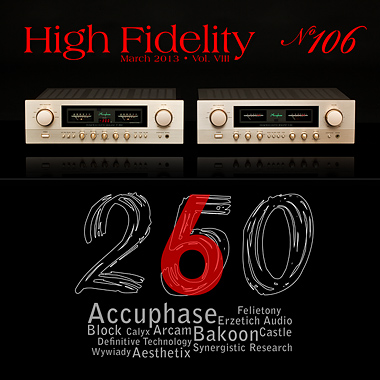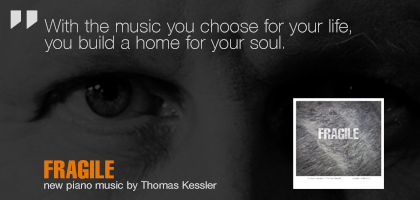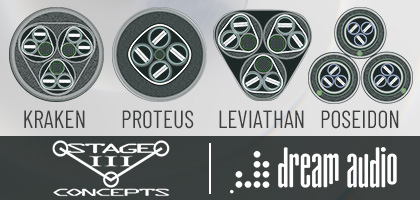 Contents
Contents
No. 242 July 2024
- COVER REVIEW: Ferrum WANDLA GOLDENSOUND EDITION ⸜ digital-to-analog converter » POLAND
- AUDIO SHOW ⸜ coverage: HIGH END 2024 ⸜ Munich » GERMANY
- REVIEW: Daniel Hertz MARIA 350 ⸜ integrated amplifier » ITALY
- REVIEW: Lumin P1 MINI ⸜ file player » HONG KONG
- REVIEW: Thunder Melody AC FEMTO BLACK (2024) ⸜ AC power cable » POLAND
- REVIEW: Laiv HARMONY DAC ⸜ digital-to-analog converter » SIGAPORE
- MUSIC ⸜ review (in Polish): Three Blind Mice: KOSUKE, MOTOHIKO, YAMAMOTO ⸜ remaster 2024 • SACD/CD » JAPAN


|
MY PLACE ON EARTH, I listen to music every day, at least for a few hours at a time. Sometimes I do this professionally, when I’m testing products or reviewing CDs, and sometimes I do it for my own pleasure – half the records are new, and the other half are old. There’s tons of it, and I face a daily dilemma of what’s worth listening, and what will have to wait. Many CDs end up in a box labelled “someday”. I spend about as much time in front of an audio system as some spend behind the wheel, on the phone, at the cash register, in uniform, in a swimming cap, with scissors in hand, in front of the computer, or at the gym. Contrary to the meagre list of professions above, I have the comfort of freely choosing my work environment – the listening room. Or nearly freely. 
I’m not the only one like this, many manufacturers, reviewers, and music-lovers have a similarly arranged house, where there is no separate place for listening only, which no-one besides you would have access to. 
Dear Wojciech-san, 
Dear Wojciech-san, 
Like I said – you can even do it on your sofa. Please take a look at the photos numbered 02, 03 and 04 – everything is pretty straightforward. But… 
In a hypothetical situation, in which I, a reviewer, am allowed to do anything at home (and not “almost” anything), I would be interested in another chair – even rarer and more expensive. Do you remember the CanCans headphone stand from Klutz Design? I have three different ones, they are great and I also use them for photo-shoots, when I test headphones or headphone amplifiers (see HERE). Cecilia Lütz and Michael Hollesen, the designers and the company owners, this time designed a chair. Not just any chair – a dream chair, a reference chair. Externally, it was made with music reviews in mind. That’s where the comfortable headrest, sitting space and hollow arm-rests to neatly hold remote controls come from. The couple writes on their website: 
|
CONVERSATIONS XIV In February’s editorial titled Musical stock-taking for the very first time I published a few short CD reviews, which didn’t fit in regular, long articles. I anticipated your reactions apprehensively, but it seems you’ve been quite accepting of this form of presentation, thinking it’s better than nothing. This time I’d also like to present a few new releases, and announce that a “real” CD review of Random Trip from Nowe Nagrania, Mikolaj Bugajak’s label, is coming in the next edition of “High Fidelity”. It will contain an interview and an alternative mix of one of the tracks which should become exclusively available to “High Fidelity” readers sometime in March. I highly recommend all the CDs briefly reviewed below, especially to those who feel strongly about a given music genre – the weak stuff is a waste of time! Jethro Tull Thick As a BrickChrysalis, 461923, CD + DVD (PCM 24/96), 2012 
This record, originally released on March 3rd, 1972, contained a single suite divided into two parts (CDs didn’t exist back then…) appeared last year as a beautiful 40th Anniversary Set. It consisted of two discs – a CD and a DVD, as well as a fantastically prepared booklet with the original “St. Cleve Chronicle” and a multitude of photos from the time. The DVD contains a few different version of the album: a multi-channel 5.1 DTS and Dolby Digital mix, as well as – what’s more important to us – PCM 24/96 files with two more versions, this time stereophonic – a new re-master and a 1972 master converted to digital format.
Sound quality: Clan of Xymox Kindred SpiritsMetropolis Records, MET 832, CD, 2012 
Although the CD was released on the 9th of October, 2012, the release date on my copy is 2011. Interesting... Ronny Moorings’ previous CD, Darkest Hour was released in 2011, right? (More on the album HERE). Such a fast release of another album was possible only because it was kind of a side project. This time this gothic/dark wave band decided to release a cover album. It’s a difficult task to undertake, and many fail, yet everything sounds pretty good here – it’s all quite nice to listen to, actually. Even a cover of A Question of Time by Depeche Mode is done well, although I usually don’t find it digestible.
Sound quality: Pro Pacem Hesperion XXI • La Capella Reial De Catalunya • Jordi SavallAlia Vox, AVSA9894, 1997-2010/2012, SACD/CD 
Another wonderfully released CD by Alia Vox – or Jordi Savall, this time dedicated to peace. The disc is a diorama of nineteen centuries of wars. You will find here invocations, Gregorian chants, the motets by Binchois, Josquin, Guerrero and Evo Pärt. The booklet contains texts about war in different languages. Thus – it’s music for peace, talking about violence… An incredible publication, both visually and sonically. A real gem. It was released on the 3rd of December, 2012. Sound quality: Karajan & Kallas 4 Great OperasEMI/Esoteric, ESSE-90072/80, 9 x SACD/CD 
It’s difficult to talk about this publication without getting emotional. This set, which costs 800 American dollars on elusivediscs.com contains the essence of opera music, four albums of Maria Callas and Herbert Von Karajan, in Strauss’ Salome, Verdi’s Aida, Bizet’s Carmen and Pucini’s Tosce. The two last discs honor Callas, and the first three are in honor of Karajan. The box was published as part of the MasterWorks series, prepared by Esoteric for the past five years, from the 20th anniversary of its creation. The said operas were prepared for the 25th anniversary. I have almost all the discs in the series and they are model editions to me – both editorially and sonically. 
The material was re-mastered at JVC Mastering Center, in other words where the XRCDs are made, and Kazuie Sugimoto is responsible for the sound. The re-master is made on DSD files – the final disc is a SACD/CD hybrid (please refrain from frowning and give it a shot). Esoteric’s D/A D-01VU converter and the G-0Rb Master Clock (Rubidium), as well as the Mexcel series cables from Acrolink are used during work on the new versions. You can see interesting things on the pictures from the studio, such as the fact that the top covers have been taken off all the devices. The four corners of the DAC and the master clock unit sport small pyramids of quartz and wood on top of which, at some distance from the device, sit heavy metal plates (copper?), while the playback amplifier doesn’t have a top cover at all. 
The music is sheer craziness, a true classic. Its new sound is equally touching. The publication is horribly expensive, granted, but as long as you can afford it, it’s a must have! The discs were pressed in Japan, and that’s also where the printing was done. 
Sound quality: 8-9/10 Wojciech Pacuła |
About Us |
We cooperate |
Patrons |
|
Our reviewers regularly contribute to “Enjoy the Music.com”, “Positive-Feedback.com”, “HiFiStatement.net” and “Hi-Fi Choice & Home Cinema. Edycja Polska” . "High Fidelity" is a monthly magazine dedicated to high quality sound. It has been published since May 1st, 2004. Up until October 2008, the magazine was called "High Fidelity OnLine", but since November 2008 it has been registered under the new title. "High Fidelity" is an online magazine, i.e. it is only published on the web. For the last few years it has been published both in Polish and in English. Thanks to our English section, the magazine has now a worldwide reach - statistics show that we have readers from almost every country in the world. Once a year, we prepare a printed edition of one of reviews published online. This unique, limited collector's edition is given to the visitors of the Audio Show in Warsaw, Poland, held in November of each year. For years, "High Fidelity" has been cooperating with other audio magazines, including “Enjoy the Music.com” and “Positive-Feedback.com” in the U.S. and “HiFiStatement.net” in Germany. Our reviews have also been published by “6moons.com”. You can contact any of our contributors by clicking his email address on our CONTACT page. |




 |
     |
main page | archive | contact | kts
© 2009 HighFidelity, design by PikselStudio,
projektowanie stron www: Indecity










